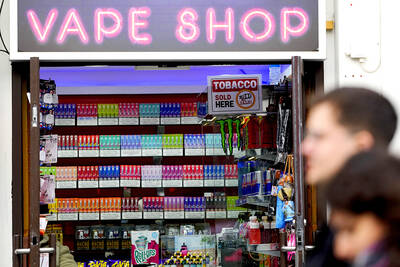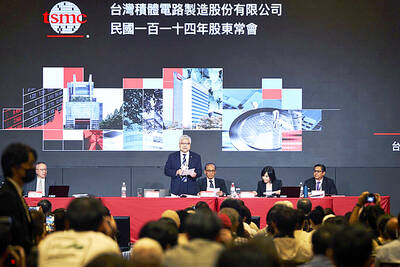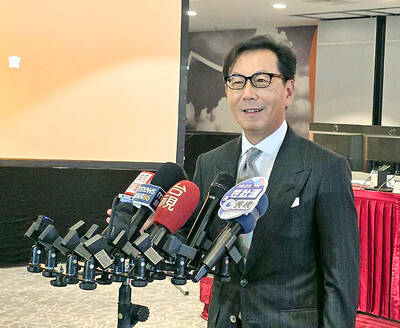China’s trade surplus with the US widened last year, underlining the failure of US President Donald Trump to narrow the gap during his tenure, as demand soared for electronics and medical equipment during the COVID-19 pandemic.
The increase came on the back of a jump in exports through most of last year as Chinese factories kicked back into gear from the second quarter following a strict lockdown that managed to broadly contain COVID-19 and allow economic activity to return.
Trump had made addressing the US’ large trade gap with China a priority when he took office four years ago and signed a partial agreement with Beijing to boost the country’s purchases of US goods such as soybeans.
However, Chinese customs data showed that the surplus with the US climbed 7.1 percent to US$316.9 billion last year.
The figure is a 14.9 percent jump from 2017’s surplus of US$275.8 billion — which was already a sensitive political issue due to Trump’s claims that China promoted unfair practices and killed US jobs.
The world’s second-largest economy in the first quarter of last year experienced a record contraction as COVID-19 essentially brought all activity to a halt, but it soon recovered as lockdowns around the country were eased and people went back to work.
Total exports rose 3.6 percent, although imports shrank 1.1 percent.
However, last month alone, exports and imports rose more than expected, 18.1 percent and 6.5 percent respectively.
“With the pandemic under control in China, factories and export-oriented companies have resumed normal operations earlier than most other countries, allowing China to meet global demand better,” AxiCorp Financial Services Pty chief global markets strategist Stephen Innes said.
China last month posted a trade surplus of US$78 billion, which analysts said was “at or near record levels.”
Chinese Customs Administration spokesman Li Kuiwen (李奎文) yesterday told reporters that “facing unprecedented difficulties and challenges, our country’s imports and exports delivered a brilliant report card,” adding that the outcome was “significantly better than expected.”
Li said that outbound shipments of electronics rose, with increases seen in notebook computers and household appliances, as well as medical instruments and equipment.
ING Bank NV chief economist for Greater China Iris Pang (彭藹嬈) said that Chinese exports likely did well as “other exporters for most of the year had been in difficult positions because of COVID-19,” shifting more orders to China.
Concerning the US-China surplus, she said that restrictions due to the COVID-19 outbreak in the US would also have hit its export capacity.
Nomura Holdings Inc chief China economist Lu Ting (陸挺) said that Chinese imports from the US last month jumped 45 percent year-on-year, “pointing to Beijing’s continued effort to fulfill its commitments on the phase 1 trade deal.”
US-China relations have deteriorated to their worst in decades under the Trump administration, largely because of the trade dispute that saw Washington hit Chinese imports with huge tariffs — drawing retaliation and tit-for-tat moves.
Overall, Lu said that he expects export growth to “remain elevated” for the first half of this year, partly because of another wave of COVID-19 infections bolstering demand for protective equipment and work-from-home products around the world.
In an interview with the Wall Street Journal this week, US Trade Representative Robert Lighthizer defended the Trump administration’s tactics of imposing tariffs on hundreds of billions of dollars of Chinese goods, saying that Trump had “changed the way people think about China.”

CAUTIOUS RECOVERY: While the manufacturing sector returned to growth amid the US-China trade truce, firms remain wary as uncertainty clouds the outlook, the CIER said The local manufacturing sector returned to expansion last month, as the official purchasing managers’ index (PMI) rose 2.1 points to 51.0, driven by a temporary easing in US-China trade tensions, the Chung-Hua Institution for Economic Research (CIER, 中華經濟研究院) said yesterday. The PMI gauges the health of the manufacturing industry, with readings above 50 indicating expansion and those below 50 signaling contraction. “Firms are not as pessimistic as they were in April, but they remain far from optimistic,” CIER president Lien Hsien-ming (連賢明) said at a news conference. The full impact of US tariff decisions is unlikely to become clear until later this month

Popular vape brands such as Geek Bar might get more expensive in the US — if you can find them at all. Shipments of vapes from China to the US ground to a near halt last month from a year ago, official data showed, hit by US President Donald Trump’s tariffs and a crackdown on unauthorized e-cigarettes in the world’s biggest market for smoking alternatives. That includes Geek Bar, a brand of flavored vapes that is not authorized to sell in the US, but which had been widely available due to porous import controls. One retailer, who asked not to be named, because

CHIP DUTIES: TSMC said it voiced its concerns to Washington about tariffs, telling the US commerce department that it wants ‘fair treatment’ to protect its competitiveness Taiwan Semiconductor Manufacturing Co (TSMC, 台積電) yesterday reiterated robust business prospects for this year as strong artificial intelligence (AI) chip demand from Nvidia Corp and other customers would absorb the impacts of US tariffs. “The impact of tariffs would be indirect, as the custom tax is the importers’ responsibility, not the exporters,” TSMC chairman and chief executive officer C.C. Wei (魏哲家) said at the chipmaker’s annual shareholders’ meeting in Hsinchu City. TSMC’s business could be affected if people become reluctant to buy electronics due to inflated prices, Wei said. In addition, the chipmaker has voiced its concern to the US Department of Commerce

STILL LOADED: Last year’s richest person, Quanta Computer Inc chairman Barry Lam, dropped to second place despite an 8 percent increase in his wealth to US$12.6 billion Staff writer, with CNA Daniel Tsai (蔡明忠) and Richard Tsai (蔡明興), the brothers who run Fubon Group (富邦集團), topped the Forbes list of Taiwan’s 50 richest people this year, released on Wednesday in New York. The magazine said that a stronger New Taiwan dollar pushed the combined wealth of Taiwan’s 50 richest people up 13 percent, from US$174 billion to US$197 billion, with 36 of the people on the list seeing their wealth increase. That came as Taiwan’s economy grew 4.6 percent last year, its fastest pace in three years, driven by the strong performance of the semiconductor industry, the magazine said. The Tsai